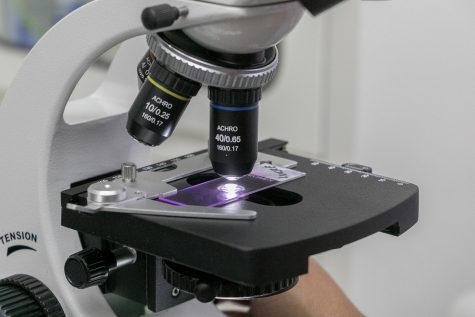A look at the university’s non-STEM researchers
From observing legislation to creating an artistic exhibit regarding the Zika virus, non-STEM research comes in all shapes and sizes.
March 19, 2018
F
or most, research means looking under a microscope and attempting to unveil the cure to cancer.
For others, it means playing with pigments and flipping through legislative documents.
For years, the spotlight — and the funding — has always favored STEM: science, technology, engineering, and math. But there’s a whole world of researchers who don’t wear white coats or safety goggles. They wear oversized t-shirts and pajama pants and sit behind a computer.
These are the non-STEM researchers.
Looking through FAU’s research funding opportunities, you can find sprinkles of non-STEM grants available. One of them is a Cultural Anthropology program, tucked in between “The Application of Big Data Analytics to Drug Abuse Research” and “Pilot Clinical Trials for the Spectrum of Alzheimer’s Disease and Age-related Cognitive Decline.”
So why does it seem like most research is primarily STEM-based?
Dr. Tracy Baker, the Assistant Program Director at FAU’s Office of Undergraduate Research and Inquiry (OURI) said it’s because students have the misconception that research is just looking through a microscope, when in actuality it can mean looking at works from Shakespeare.

“Asking questions is the basis of what research is,” Baker said. “Any discipline can ask questions.”
For example, senior criminal justice and sociology major Caralin Branscum wanted to know how sexual assault is addressed in state legislature, so she made it her mission to do just that.
She has been investigating voluntary victim intoxication in sexual assault for a little over a year, sifting through data sets from every single state to find out if and how the governments define intoxication.

“One of the biggest things we want to do is see where there are gaps in the laws and inconsistencies and highlight those gaps,” Branscum said.
Branscum is a two-time attendee of FAU’s annual Undergraduate Research Symposium, and noticed a clear ratio during her experience.
“There was obviously more STEM than non-STEM researchers — which isn’t a bad thing, it’s just a fact,” she said.
Although that may not be a bad thing, it can impact what students even consider research.
The silver lining of non-STEM research is that a great portion of it can be ambiguous and theory based, requiring critical analysis and interpretation — although that may be part of the reason that “it’s a little less inviting,” according to co-editor of the FAU research journal and biology major, Luca Brunozzi.
Dr. Baker occasionally asks classes, “Do you think there’s research in your field?” and she observed that it’s often the STEM majors that raise their hand in a heartbeat while the others aren’t sure.
“There’s a need for more non-STEM engagement,” she said.
One thing that she has noticed is that STEM majors have a “higher sense of self-efficacy” and “higher confidence in research-related tasks.”
This happened to be the case with Branscum. Before becoming a seasoned researcher in both criminal justice and sociology, she had dipped her toes in research by taking an introductory research class — and almost dropped it the first week.
“I thought it would be all science people and that’s not really my thing … I had the misconception that research was just a STEM thing, but I stayed in the class and learned that research was non-STEM too,” she said.
You may not find Branscum’s research on a pharmaceutical shelf, but intangible does not mean impractical.
“It’s a practical analysis of legislation where reform could take place,” she said.
Research is not a binary concept of only STEM or non-STEM — it can also be a balanced hybrid of the two, and according to senior anthropology major and primatology researcher Sandra Almanza, this is the case within the anthropology field.
Sandra’s research on the genetic backgrounds of vervet monkeys in Dania Beach, Florida falls under the umbrella of biological anthropology, and serves to advance conservation efforts.
Despite spending her days doing “DNA extraction from deceased primate specimens” and “running statistical analysis on the computer,” Almanza said that cultural anthropology can creep its way in and establish a place in the lab.
Other primatology researchers who go into foreign countries like the Democratic Republic of Congo and Tanzania must account not only for the primates, but for the people.
They can’t wander aimlessly through foreign terrain — they “have to learn about their background, region, area, religion and customs,” Almanza said. “[The Africans] have to be willing to accept you, and that’s where I think cultural anthropology comes in.”
Primatology research isn’t the only thing that can be derived from non-STEM ideas. Even public health can be driven by the unexpected.
The duo of art professor Julie Ward and biology/art student Sarah Rabinowitz teamed up to tackle the topic communicable diseases through the visual arts.
The pair’s three-part research project heightened social awareness of the transmission of diseases through sound, video, and performance installations.
The performance installation had student actors cloaked head-to-toe with cotton mosquito netting, socializing with the audience to bring awareness of the Zika virus.
“The Zika suits created conversations on the limitations to social interactions created by communicable diseases. During the performance, the Zika suit created this separation between the wearer and the viewer — the person wearing the suit was protecting themselves from the environment and those around them,” according to Rabinowitz’s website. “The work prompts two questions for the spectators: 1. What in the environment are they protecting themselves from? And 2. Are they protecting themselves from me, and if so, how am I a threat to this person?”
The STEM world can raise mindfulness of these issues using jargon and statistics, but the results of Ward and Rabinowitz’s artistic research methods proved useful to creating real conversations “by putting people in the position where disease protection is a barrier for social interaction,” Rabinowitz said.
“We can look at a data chart and we can look at how some really awesome research is going to save my niece one day. But I also believe that art can bring about general knowledge … I think people forget that you feel something when you look at art,” Ward said. “This made people think about Zika and think about its transmission.”
Co-editor of the FAU research journal and cover artist for the FAU Undergraduate Research Symposium booklet, Luca Brunozzi, agrees.
Non-STEM research “induces people to think critically, incites conversation, brings new ways of thought, and engages the viewers’ emotions and empathy,” he said.
The artist also conducts research of his own. Brunozzi blended his interest in the sciences and the arts by pursuing research on the chemistry of paint pigments.
To open the blinds and show students that research extends far beyond the lab, the researchers have a few suggestions.
Branscum believes more non-STEM students can get involved in research through peer mentor programs and through the Office of Undergraduate Research and Inquiry.
“Being a peer mentor, I get to reach out to students to do classroom presentations, and host workshops where I can say ‘hey, research is a non-STEM thing too and you should really get involved,’” she said.
Branscum believes that persuading one student at a time would go a long way in getting more students involved in non-STEM research. During her classroom presentations, she implements a “boots-on-the-ground” mentality by aiming to persuade just “one, five, or even ten people at a time” to bring awareness to the fact that research is a spectrum.
Professor Ward takes a similar stance.
“It starts with the faculty,” she said. Not one of her six students graduate and undergraduate students involved in research were the first to break the ice and approach Ward first to get started.
She encourages non-STEM students not to be scared of the “unknown [research].”
Almanza’s solution to promoting non-STEM research is to popularize it among students with diverse backgrounds and to include more women.
“Anthropological research began with older, white men — so that was the perspective it was presented to us in,” Almanza said. “If it were to be more open and more attention was brought to anthropological research … I think it would open the floodgates for people to come in and try to do more research in those areas.”
Brunozzi said it’s in the hands of the students to promote non-STEM research. He encourages them to follow their passions and pursue their curiosities.
“Work makes work,” he said. This describes the essence of research, according to Brunozzi: asking questions, creating things, and seeing what happens, regardless of subject matter.
Kristen Grau is a contributing writer with the University Press. For information regarding this or other stories, email [email protected].
















